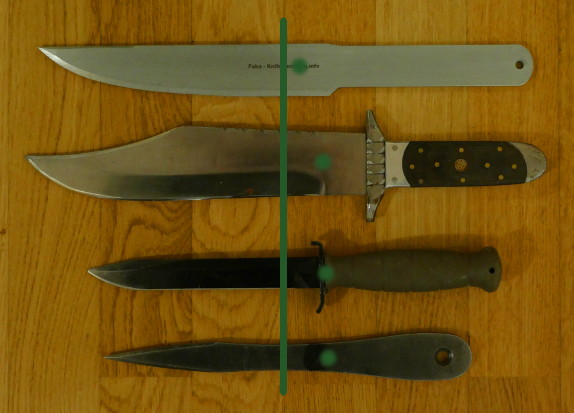 Balance of a throwing knife
Balance of a throwing knifeThe center of gravity (COG, also called center of mass) should be in the lengthwise middle of the throwing knife, plus or minus 1.5cm. Such a balanced throwing knife will make nice, round circles in the flight. If the balance point is further off the middle, say the knife is rather blade heavy, the circles of the handle and the circles of the blade in flight will be of different diameter, making the throw less predictable.
Some people say that off-balance is just an additional challenge, but I still prefer center-balanced throwing knives for two reasons:
If someone hands you an off-balanced knife to throw, you can do it, provided you remember the golden rule: Grip the light end! Hence, a blade-heavy knife would only be held and thrown from the handle. Conversely, if you grip the heavy end, the center of gravity will be inside or close to your hand, and the knife will resist a smooth release. Try out gripping the wrong (heavy) side, and experience the awkward feel in a throw.

When looking at how to balance a throwing knife perfectly, often a ratio of weight per length is mandated. In his classic book Knife throwing - a practical guide (p. 18) McEvoy recommends one ounce per inch (11 g per cm). In practice, this sweet spot seems to be far more flexible. There are excellent throwing knives available that range from the Glock (6.9 g/cm), Hibben (7.1) and Dubé (8.8) on one end to the Faka (11), Perfect Balance (12.5) or even a hefty Mountain Bowie (14.9 g/cm) on the other.
Some knife throwers have a strong personal preference for holding the knife at the blade. They use a big arch for their throw and like its slow half spin rotation.
In no spin knife throwing, the suitable balance depends rather much upon the personal throwing style. The recommendations go from neutral-slightly handle balanced to handle heavy - the ![]() Bearded Rat advocates a balance point at 39% of the overall length (towards the handle) for instinctive throwing. In fact, for beginners it is easiest to start no spin throwing using a handle heavy throwing knife like the Arrow (40%).
Bearded Rat advocates a balance point at 39% of the overall length (towards the handle) for instinctive throwing. In fact, for beginners it is easiest to start no spin throwing using a handle heavy throwing knife like the Arrow (40%).

There are throwing knives in the market with built-in movable, adjustable weights. I do not recommend them, it is too easy to get obsessed with adjusting the weight - with a negligible effect on the balance. If a knife does not stick, you change the distance or your grip, not the knife. Plus, the grooves for the weights are not easy to clean, and the weights are prone to come loose.
The overall recommendation for a center balanced throwing knife for beginners is the Faka.